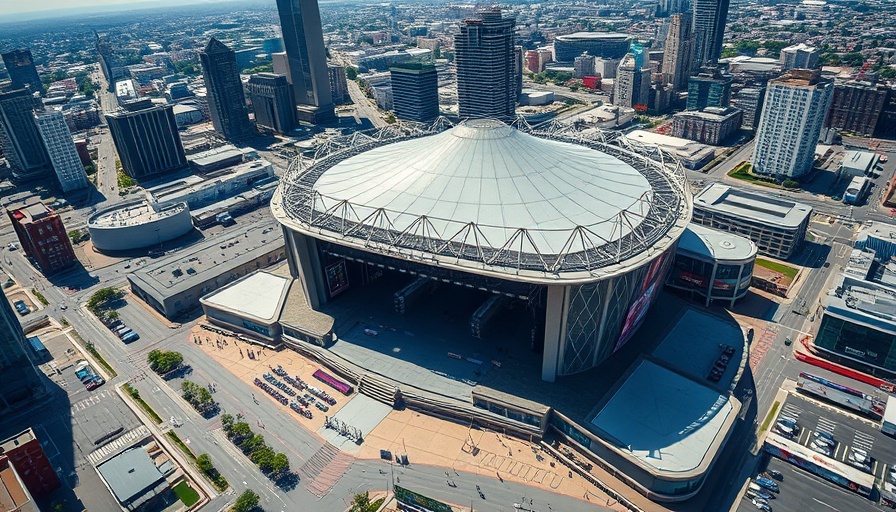
The Future of San Antonio’s East Side Entertainment Venues: A Community Perspective
As San Antonio grapples with its future, the East Side stands at the edge of a transformative moment. Recent town halls have ignited passionate dialogue among residents and officials about revitalizing the East Side's two key entertainment venues: the Frost Bank Center and Freeman Coliseum. Spanning nearly 400 pages, Bexar County Commissioner Tommy Calvert’s report details vibrant community suggestions aimed at reshaping the landscape of this historically underserved region.
Community Vision: Economic Development and Inclusivity
The heart of the recommendations echoes a commitment to economic development that benefits all residents. Participants voiced the need for policies that ensure local voices are incorporated into any future planning initiatives. “Residents are demanding innovative plans and job-inducing industries that spur economic development,” Calvert’s office reported, emphasizing that the East Side has historically been denied the economic opportunities enjoyed by more affluent neighborhoods.
Proposals ranged from refurbishing local arenas with modern amenities—like parks and cafés—to ensuring that existing businesses, previously impacted by construction disruptions, have avenues for recover. Suggestions for harmonizing cultural identity while upgrading facilities reflect a broader desire to foster community cohesion amidst urban growth.
Transformative Projects in the Pipeline
A notable buzz surrounds “Project Marvel,” a sweeping initiative intended to propel the city’s downtown entertainment district into a more dynamic future. Proposed alongside this project is the need for more than just infrastructure; residents stress the importance of building spaces that prioritize education and community health. From local gardens to hospitals, investing in people seems to be a prevailing sentiment, an acknowledgment that economic development must be holistic to genuinely transform lives.
Furthermore, the proposal to introduce a Texas A&M graduate veterinary school is particularly appealing. It represents not just jobs and education, but a way of connecting local students with real opportunities, redefining education's role in economic revitalization.
Challenges and Concerns: Navigating Urban Development
The conversation at the town halls was not solely optimistic; it profoundly acknowledged fears regarding changing city dynamics. Some residents expressed anxiety over gentrification, wary that increased accessibility to the East Side could lead to an influx of wealthier populations and the displacement of long-standing residents. City officials must tread carefully to ensure thriving communities are preserved amid urban development.
In their discussions, participants expressed a united front against plans for a casino in the area, citing concerns about organized crime and social displacement. This collective opposition underlines a critical community value: maintaining a safe and prosperous environment that prioritizes quality of life over fleeting economic benefits.
Infrastructure: Bridging Gaps and Building Connections
Urban planners are not ignoring the impact of highways like I-37 that have historically severed connections between neighborhoods. Utilizing federal grants, San Antonio proposes projects aimed at reconnecting the East Side with downtown. This initiative may include land bridges that facilitate pedestrian access, providing not just physical connections but a means for social and economic interaction that has long been stymied by urban planning decisions.
The efforts reflect a growing recognition of how urban design can profoundly affect community dynamics, especially in neighborhoods that have historically faced neglect and marginalization. By investing in sustainable transportation solutions, the city envisions a network that could bolster local businesses and enhance residents’ access to city resources.
Moving Forward: Engaging Community Voices
As San Antonio stands at a pivotal juncture in its history, engaging directly with community members remains fundamental. Plans to create feedback loops with local organizations, neighborhood associations, and economic development nonprofits are critical to ensuring that development projects align with the community’s aspirations.
This collective engagement is not merely a bureaucratic necessity but a valued component of rejuvenating the East Side. Empowering residents to share their visions helps to foster a sense of ownership in this regeneration process.
Conclusion: A Call for Action
The path forward for San Antonio's East Side is filled with potential. While challenges lie ahead, the commitment from residents, local leaders, and community organizations can shape a future defined by shared prosperity. Residents are encouraged to continue participating in local discussions, ensuring that their voices are heard as the city embraces its future. By collaboratively envisioning the next chapter for the East Side, San Antonio can truly thrive.
 Add Element
Add Element  Add Row
Add Row 



 Add Row
Add Row  Add
Add 


Write A Comment